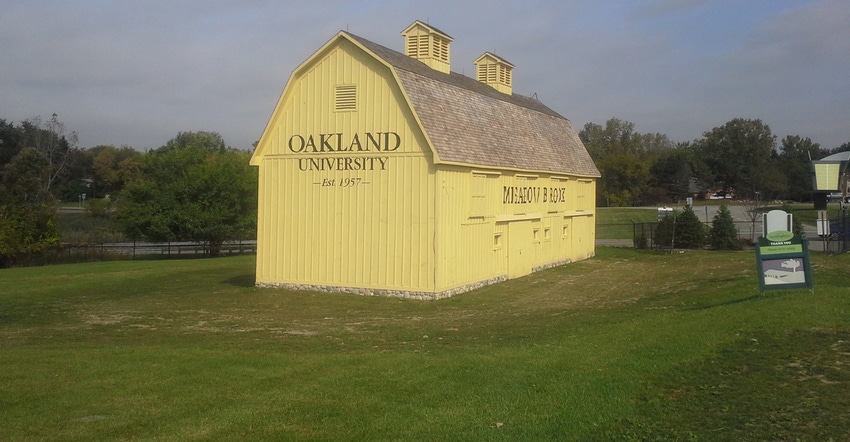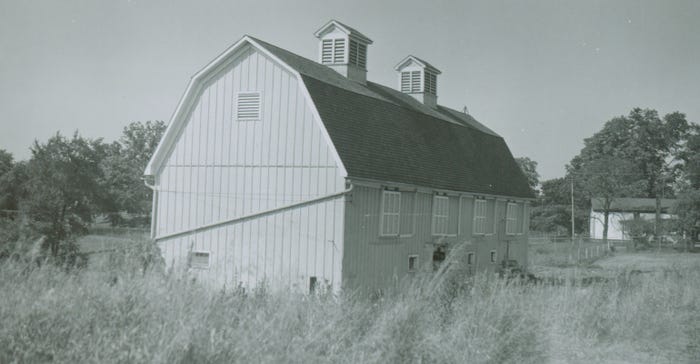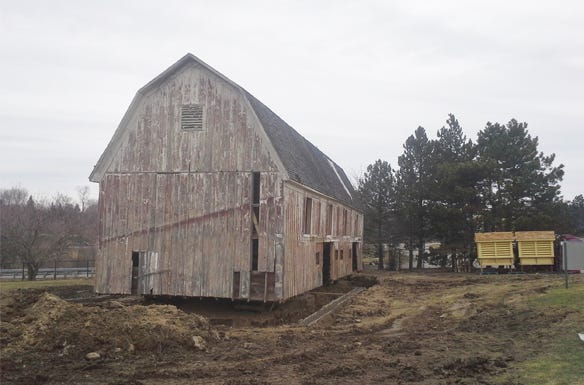October 10, 2018

One of the surest ways to “go green” is to make use of structures that already exist, particularly when they are well-built and rich in history. Barns are often a perfect example, as these extraordinary timber-framed structures of the 1800s and early 1900s offer a multitude of opportunities for new uses. Their old-growth wood components can rarely be matched today.
Oakland University’s (OU) Rochester, Mich., campus was once the site of Meadow Brook Farms, which reached into the communities of both Rochester Hills and Auburn Hills. The farm has a fascinating history, and at one time, had a collection of many beautiful barns, each with its own purpose and story.
The land was first settled in 1820 by Samuel S. Hubbell. In the late 1800s, a subsequent owner of the property used it as a “retreat from the city,” leading many today to contemplate comparisons in population density then and now.
Farm buildings, stock and 320 acres were purchased by newlyweds John and Matilda Dodge in 1908. Matilda and her second husband, Alfred Wilson, operated the farm for some 30 years, moving two barns from their location near the original farmhouse to a site along Pontiac Road (now Walton Boulevard). They donated their entire estate and massive Meadow Brook Hall home to Michigan State University in 1957. MSU made use of the property for its Oakland campus until making the decision to let Oakland University become its own institution in 1970. By this time, some barns had been demolished, others were given new uses, and some were failing in the process that Stephanie White termed “demolition by neglect.”
White, now senior project designer with Ekocite Architecture, Royal Oak, was a graduate student in Lawrence Technological University’s Master of Architecture program with a concentration in sustainable building in 2010, when she was drawn to barns falling into ruin on the OU campus. Richard Stamps, on staff at OU at the time, was the barns’ advocate and defender, and encouraged White to draw attention to their plight and importance.
White focused her graduate thesis on the study of and recommendation to save what was known as the “south” barn, which was in somewhat worse condition than the “north” barn, but in her estimation, savable.

ARCHIVAL PHOTO: A 1956 photo of the north barn from the archives of Oakland University documents a sturdy sheep barn with two cupolas.

With the help of others knowledgeable about heritage barns, White assessed every aspect of the timber-frame, six-bay south barn and its fieldstone foundation. She also evaluated other measures of a heritage barn’s value — age and rarity, architectural, cultural, research and knowledge, social and symbolic — and concluded that the barn ranked “high” for all criteria.
As is true for many barns, documentation of when it was built, by whom and at what cost is often sketchy or nonexistent, except by accident in family journals, letters and photos. While it is certain that without good barns, early farms could not have prospered, they are structures taken for granted by history. Based on unique marks left on the framing during construction, White estimated the south barn to be about 120 years old.
North barn saved
“Stephanie’s thesis did bring awareness,” says Geoff Upward, executive director of OU’s Meadow Brook Estate. “Stephanie’s focus was on the preservation of the south barn. The university’s decision to tear it down was based on the degree of deterioration and a justification of utilizing materials to preserve the north barn.”
For barn believers, it was a partial victory, but a victory nonetheless. The north barn, while not as historically valuable as its companion, still had good potential for renewed life and, with its classic cupolas, was memorable.

NEW FOUNDATION: The term “barn raising” typically means building a barn from the ground up, but in this case, the Meadow Brook north barn was literally raised for the pouring of a new foundation.

Today the award-winning north barn is used by the university for storage. Returned to its original bright yellow color — said to be Matilda Dodge’s favorite color — it attracts attention as a community icon, with hundreds of vehicles passing it each day. Plans are now to make it part of OU students’ educational experience.
“We are in the process of supporting development of a student organization focused on Meadow Brook and OU history,” Upward says. “OU has an active and successful student organic farm where several of the poultry barns still stand. We are working with OU’s Student Affairs division to put early Meadow Brook Farms photographs on the walls of the newly expanded student center on campus.”
Other structures saved and used on the OU campus include another sheep barn, root cellars, a Belgian barn, the Dodge farmhouse and four horse barns.
Helping younger generations understand and appreciate the work of the people and the purposes of structures that preceded their footprints on the land is important and can influence their sense of place and career. There is an expense associated with saving heritage buildings, but ultimately, going green delivers benefits beyond the obvious, and often well beyond the known. And that saves even more green.
Arnett writes from Battle Creek, Mich. Special thanks to Stephanie White for access to “A Thesis Presented to the Faculty of the Graduate School of Lawrence Technological University in Partial Fulfillment of the Requirements for the Degree of Master of Architecture, May 2012.”
About the Author(s)
You May Also Like




